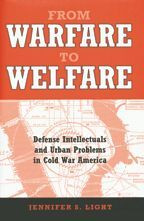
Reviews
An exceptionally useful contribution to the history of American cities, a book that takes seriously and does much to document the historical relationship between militarism and urban geography.
As historians of American cities stumble across missile experts straying far from their silos, they will find guidance in this careful account of a peculiar moment in urban policy.
A very interesting book about the way in which American institutions get bamboozled into adopting popular fads and trends that ought to be scrutinized more carefully.
Light stands some of the conventional Cold War wisdom on its head... This study not only closes the loop between business management and the military back to the civilian sector, but also reminds readers of the continuing nature of unintended consequences that flow from expert technological obsessions when allied to policy making.
If the volume tells us something new and important about the history of planning, it is at the same time a cautionary tale, one that might well offer lessons to those today who are proposing many related technologies—geographic information systems, remote surveillance systems and the like—as a means for solving urban and military problems.
A compelling historical narrative that exposes a little-known linkage between defense and civilian affairs: the urban-planning applications of technologies and management styles that were developed originally for national defense.
In this superbly written intellectual history, Jennifer Light describes the impact on urban planning of the cybernetic revolution, which advanced a general theory of biological and machine communications after World War II.
Light has made an important contribution by showing how defense intellectuals contributed to the creation and promotion of cybercities.
This well-written study introduces a new and important cast of urban decision-makers to the story of post-war urban America.
A strong and useful contribution to American Cold War history, and perhaps even more to an understanding of the nature of American power after the Cold War.
Light demonstrates how careful attention to the connection between cold war planning and urban planning forces us to rethink the recent history of the American city. This is really a study of how defense intellectuals managed to convince a couple generations of planners and politicians that they had something valuable to learn from RAND, JPL, and NASA.
This is an outstanding presentation and analysis that should attract significant attention especially recognizing current issues in this area. Jennifer Light has produced an outstanding discussion and evaluation of the capabilities, efforts, tools, and contributions of technologists, scientists, managers, planners, analysts from the military, aerospace, and other federal government agencies.
Book Details
Acknowledgments
Introduction
1. Planning for the Atomic Age: Creating a Community of Experts
Part I: Command, Control, and Community
2. The City as a Communication System
3. Cybernetics and Urban Renewal
Pa
Acknowledgments
Introduction
1. Planning for the Atomic Age: Creating a Community of Experts
Part I: Command, Control, and Community
2. The City as a Communication System
3. Cybernetics and Urban Renewal
Part II: Cities in the Space Age
4. Urban Intelligence Gathering
5. Moon-Shot Management for American Cities
Part III: The Urban Crisis as National Security Crisis
6. Cable as a Cold War Technology
7. Wired Cities
Conclusion
Notes
Note on Sources
Index





